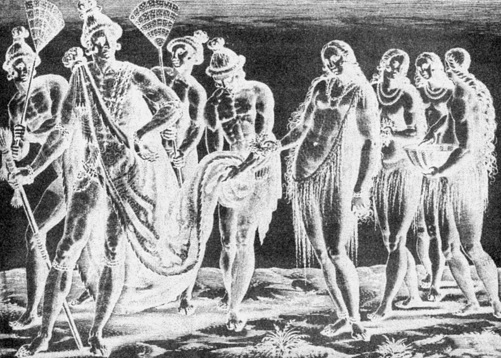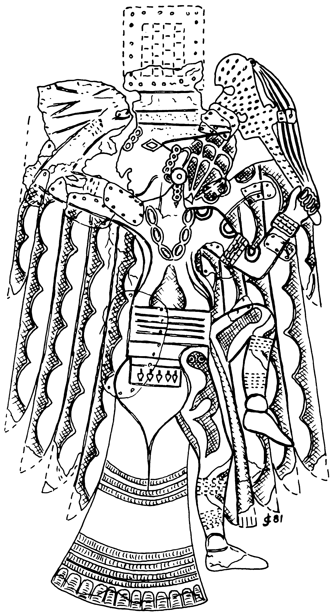The History of Florida (3 page)
Read The History of Florida Online
Authors: Michael Gannon
Tags: #History, #United States, #State & Local, #Americas

proof
nearly all of Florida at this same time.
Although squashes and gourds probably were grown in gardens even in
the late Archaic period, it was not until A.D. 750 or even later that some of
the northerly St. Johns peoples began to cultivate corn. Food production,
in conjunction with hunting, collecting, and fishing, could support larger
human populations. Many more post–A.D. 750 St. Johns vil ages are known
than earlier sites, reflecting this population increase.
Agriculture, important to native groups in the central portion of penin-
sular Florida and the eastern Panhandle, led to changes in lifeways. After
about A.D. 1000, some of the St. Johns groups living along the northern St.
Johns River constructed large sand mounds to serve as bases for temples or
for residences in which their leaders lived. Larger populations, a desire to
understand and try to control such things as agricultural fertility and rain-
fal , and the need for more social cooperation in order to maintain fields
and protect territory stimulated the development of more complex forms of
political organization and new beliefs and ceremonial practices.
With the coming of agriculture, vil age leaders were replaced by chiefs
and religious figures, who exercised control over the people and sought
to bridge the gap between the vil agers and the supernatural. Often these
Original Inhabitants · 9
chiefly and religious officials were associated with special objects and sym-
bols, visible reminders of their power. Through al iances or the threat of
military force, some chiefs sought to extend their political power and in-
crease the territory under their aegis. At times such leaders control ed outly-
ing vil ages and their chiefs, receiving respect and tribute from those chiefs
as symbols of their allegiance.
Many vil ages of the St. Johns region, some with large mounds, were in-
habited in the early sixteenth century when Europeans first entered the inte-
rior of east Florida and traveled up the St. Johns River. From that period on,
we have written records left by those Europeans which offer firsthand de-
scriptions of the early colonial-period descendants of the St. Johns people.
Those descendants include many eastern groups speaking the Timucuan
language who lived along and near the St. Johns River and its tributaries,
groups with names like Saturiwa, Utina, and Acuera.
In northwest Florida and the interior of northern Florida and along the
Gulf coast from Cedar Key north, the earliest post-500 B.C. regional cul-
ture was cal ed Deptford. Especial y numerous in locales adjacent to the
salt marshes and tidal streams of the Gulf coast are vil age sites and fish-
ing camps characterized by the distinctive Deptford pottery (decorated
with check-stamped and grooved surface designs applied by using carved
proof
wooden or clay paddles to malleate the surface of the ceramic vessels before
they were fired). Smaller hunting camps are found inland.
In the Panhandle after about A.D. 100, increased use of interior wetland
and forest resources, especial y the rivers and lakes in Gadsden, Leon, and
Jefferson Counties, led to the development of the Swift Creek culture out of
the Deptford culture. Swift Creek, with its distinctive pottery stamped with
geometric designs, was related to the Santa Rosa–Swift Creek culture that
followed Deptford in the western Panhandle at about the same time. Influ-
enced by cultures to the north of Florida, the ideology of the late Deptford
and Swift Creek cultures was associated with a rich variety of ceramic, shel ,
stone, and even copper items, some traded into the state from the north.
Many of these objects display stylized animal motifs representing the same
species important to later native Floridians as wel .
Like the Deptford people who preceded them, the Swift Creek and Santa
Rosa–Swift Creek built sand mounds in which they interred their deceased
relatives. Swift Creek vil ages are found in the interior of eastern northwest
Florida, evidence that people were moving into that region, perhaps a result
of continuing population increase.
The Weeden Island culture and its coastal and inland regional variants

10 · Jerald T. Milanich
A late-sixteenth-century engraving offers a European view of Florida Indian chief Sat-
uriwa and his wife going for a walk by their village on the south bank of the St. Johns
River near its mouth. The chief and his wife are both tattooed, a sign of their high sta-
tus, and they are wearing shell beads. Feather cloaks and tanned and painted animal
proof
hides also were worn. Male villagers typically wore breechcloths, and women dressed
in skirts skillfully woven from Spanish moss. The men’s hair was pulled up and tied.
appeared after about A.D. 300 from Sarasota County north along the Gulf
coast to Alabama as well as in the interior of north and northwest Florida.
Weeden Island, named for a site on Old Tampa Bay in Pinel as County ex-
cavated in the early 1920s, emerged out of local Deptford, Swift Creek, Santa
Rosa–Swift Creek, and related cultures that were present in that large area.
Weeden Island vil ages, often with burial mounds and other mounds in
association, are found in a variety of environments and geographical lo-
cations from Crystal River to near Lake City to Tal ahassee and beyond
to Pensacola. In each area, vil agers practiced distinctive lifeways, but they
shared many aspects of Weeden Island ideology and social and political
organization.
One Weeden Island variant culture was the Cades Pond culture of Ala-
chua County and the western portion of Putnam County. Cades Pond
peoples lived in vil ages adjacent to extensive wetlands—lakes, wet prairies,
marshes, and the like—where they could fish and gather waterbirds and a
Original Inhabitants · 11
wide variety of other wetland-dwel ing animals. They also hunted in the
adjacent forests and collected acorns, hickory nuts, and persimmons. Nu-
merous Cades Pond mounds are known, some with Weeden Island pottery.
Like the Swift Creek people in northwest Florida, Cades Pond vil ages took
advantage of the resources in the interior away from the coast to establish
settlements.
Weeden Island variant cultures also are found around Tampa Bay (the
Manasota culture) and along the north peninsular Gulf coast. In those re-
gions, people continued to practice the same patterns of subsistence as did
their late Archaic ancestors. Like the vil agers in other Weeden Island cul-
tures, they built mounds and manufactured and traded for ornate ceramic
vessels and other objects displaying a rich array of symbols important to
their beliefs. The ceramic complex associated with mounds is the defining
characteristic of these cultures.
Cultivation of corn appeared among the northern Weeden Island cul-
tures after about A.D. 800, about the same time it did in the St. Johns region.
In the eastern portion of northwest Florida, maize agriculture became par-
ticularly important to aboriginal subsistence, providing—after A.D. 100—
the economic base for the development and elaboration of the Fort Walton
culture, which eventual y stretched from the Aucil a River west through the
proof
Panhandle. Fertile inland locales—especial y the Tal ahassee Hil s zone of
Leon and Jefferson Counties and the upper Apalachicola River Val ey—sup-
ported a number of large Fort Walton vil ages, some with mounds built as
platforms on which to erect the temples and residences of chiefs and reli-
gious leaders. The Lake Jackson Mounds, in a state park near Tal ahassee, is
one such site.
Fort Walton was the largest and most political y complex precolumbian
culture in Florida. Separate political units—each consisting of a number of
vil ages, vil age chiefs, and other officials, and outlying agricultural home-
steads, al united under a paramount chief—vied with one another for power
and territory. The Apalachee natives encountered by Spanish expeditions in
the early colonial period were the descendants of precolumbian Fort Wal-
ton populations. West of the Fort Walton region in the western Panhandle,
influences from the north, from cultures in Alabama, provided the impe-
tus for the development of the Pensacola culture. Pensacola vil ages and
mounds are found clustered around the coastal bays from Choctawhatchee
Bay west. The Pensacola people probably practiced agriculture, but it was
not as extensive as the cleared-field farming of the Fort Walton culture.
Agriculture also was added to the economic system of the late Weeden

12 · Jerald T. Milanich
Line drawing of a copper
breastplate excavated at
Lake Jackson, a Fort Walton
proofarchaeological site in Leon
County. The figure depicted is
probably a person dressed in
the costume of a bird.
Island–period culture of north Florida, which occupied the region east of
the Aucil a River, north of the Santa Fe River, and west of the St. Johns River
drainage. Named the Suwannee Valley culture, the people of this post–A.D.
750 culture also never practiced agriculture as extensively as did Fort Wal-
ton farmers. The descendants of Suwannee Valley populations are the vari-
ous western Timucua-speaking groups of Madison, Suwannee, Hamilton,
and Columbia Counties who witnessed the passage of the Hernando de
Soto expedition in 1539. They include, among others, the Aguacaleyquen,
Napituca, and Uzachile.
Farther south in north central Florida from the Santa Fe River down to
Belleview in Marion County, another culture replaced the Weeden Island–
period Cades Pond culture around A.D. 600. The Alachua culture represents
a migration of a new population into Alachua and western Marion Counties
Original Inhabitants · 13
from the river valleys of southern Georgia. It is uncertain if this intrusive
culture was associated with farming when it first appeared in north central
Florida, but by about A.D. 1250, if not before, we are certain that maize was
being cultivated.
Early in their history in Florida, the Alachua vil ages expanded westward
into Levy and Dixie Counties, although they apparently did not live on the
coast itself, where vil agers continued to make their livelihood from the ma-
rine environments. The Potano Indians, a Timucua-speaking native group,
are the descendants of the Alachua population.
Around Tampa Bay, a huge estuary capable of supporting large popula-
tions, the Weeden Island–period culture developed into the Safety Harbor
culture after about A.D. 900. Safety Harbor sites are found along the Gulf
coast from Charlotte Harbor north to the Withlacoochee River in Citrus
County. The Safety Harbor people on Tampa Bay probably were not farm-
ers, but the vil agers just north of Tampa Bay did grow corn, though it was
not as important to their diet as it was in northwest Florida.
Safety Harbor sites, some with huge heaps of shellfish as well as mounds
and vil age areas, once dotted the shoreline of Tampa Bay, but many were
destroyed around the turn of the twentieth century when the shell was
mined to build roads. Today only a few of these large sites exist, such as the
